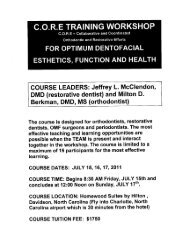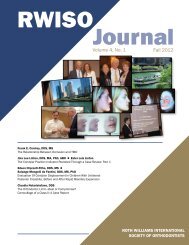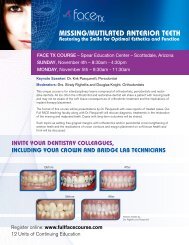2010 RWISO Journal - Roth Williams International Society of ...
2010 RWISO Journal - Roth Williams International Society of ...
2010 RWISO Journal - Roth Williams International Society of ...
You also want an ePaper? Increase the reach of your titles
YUMPU automatically turns print PDFs into web optimized ePapers that Google loves.
found that there can be extreme variation in the s<strong>of</strong>t tissue<br />
around the ear. 34 This variation can make it difficult to locate<br />
the hinge point with an arbitrary earpiece face-bow.<br />
The present study found larger mean values for the arbitrary<br />
earpiece face-bow measurements. This suggests that the true<br />
hinge face-bow may not be as sensitive to anatomical changes<br />
as the arbitrary earpiece face-bow.<br />
Goska and Christensen conducted a similar study to<br />
to the present study, in which they compared the positions<br />
<strong>of</strong> maxillary cast permanent first molars in three planes <strong>of</strong><br />
space, using four different face-bow techniques. A true hinge<br />
face-bow determined axis point was chosen as a baseline<br />
against which to compare the other three arbitrary face-bow<br />
techniques. 28 They found that deviations between this baseline<br />
and the other three face-bow mountings ranged from 1.5<br />
mm to 4 mm. 28 They found that deviations between the true<br />
hinge face-bow and the arbitrary earpiece face-bow ranged<br />
from 1.9 mm to 3.8 mm. Like the authors <strong>of</strong> the present<br />
study, they concluded that variations in the arbitrary earpiece<br />
face-bows might have resulted from naturally occurring<br />
variations in ear anatomy or the fact that the arbitrary<br />
earpiece face-bow is an average measurement. 28<br />
In general, the present study suggests that error introduced<br />
from arbitrary earpiece face-bow hinge axis location<br />
may produce occlusal discrepancies caused by malpositioning<br />
<strong>of</strong> the maxillary cast. The present study differs from<br />
other previous studies in that it evaluates changes at the<br />
occlusal level <strong>of</strong> the maxillary cast, as opposed to looking<br />
at the joint level when comparing arbitrary and true hinge<br />
mounting techniques. This study also differs from previous<br />
studies in that it does not measure the occlusal discrepancies<br />
that result from contacts during the mandibular arc <strong>of</strong><br />
closure, since the mandibular cast was not incorporated into<br />
the measurements.<br />
Zuckerman, in analog tracing the arc <strong>of</strong> the incisal edge,<br />
verified that no A-P change occurred in the arc <strong>of</strong> closure, as<br />
long as the mandible rotated along the accurate hinge axis.<br />
However, when an error in the arbitrary earpiece face-bow<br />
hinge axis occurred anterior to the true hinge, the incisor arc<br />
<strong>of</strong> closure was anterior to the actual arc <strong>of</strong> closure, and when<br />
the arbitrary earpiece face-bow hinge axis occurred posterior<br />
to the true hinge axis, the opposite effect occurred. Errors in<br />
the vertical position <strong>of</strong> the arbitrary earpiece face-bow hinge<br />
axis were found to produce the largest A-P discrepancies<br />
upon mandibular closing41 (Figure 9).<br />
52 Freeland et al | Comparison <strong>of</strong> Maxillary Cast Positions<br />
Figure 9-a True hinge mandibular cast vs. estimated hinge<br />
maxillary cast: True hinge mounting.<br />
Figure 9-b True hinge mandibular cast vs. estimated hinge<br />
maxillary cast: Estimated hinge mounting substituted for true<br />
hinge maxillary mounting.<br />
Zuckerman found that an anterior incisor displacement<br />
<strong>of</strong> 1.5 mm could occur if the arbitrary hinge axis was <strong>of</strong>f from<br />
the true hinge axis by approximately 10 mm. 41 Although the<br />
method for the present study does not incorporate the mandibular<br />
cast arc <strong>of</strong> closure, wax bite thickness, or condylar<br />
positioning, it is interesting to note that the largest discrepancy<br />
in maxillary cast position occurred in the A-P direction<br />
with a mean difference greater than 3 mm in all three areas<br />
measured (maxillary right and left first permanent molar and<br />
the upper right permanent central incisor).<br />
Gordon et al conducted a mathematical study to calculate<br />
the amount <strong>of</strong> cusp height and mesiodistal error at the<br />
second molar that results from arbitrary earpiece face-bow<br />
hinge axis location 5 mm and 8 mm anterior, superior, posterior,<br />
and inferior to the true hinge axis. 6 They concluded<br />
that incorrect location <strong>of</strong> the hinge axis caused a positional<br />
change in the occlusal relationship between the maxilla and<br />
the mandible, resulting in various premature contacts. De-








